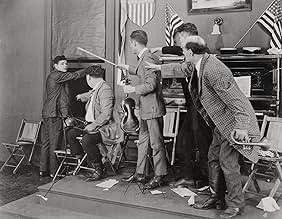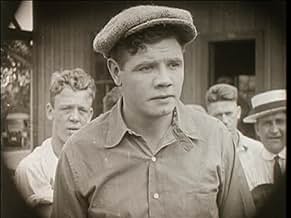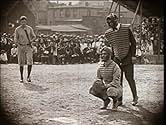Agrega una trama en tu idiomaThe "true story" of baseball great Babe Ruth; Ruth plays himself.The "true story" of baseball great Babe Ruth; Ruth plays himself.The "true story" of baseball great Babe Ruth; Ruth plays himself.
- Dirección
- Guionistas
- Elenco
Ralf Harolde
- John Tobin
- (as Ralph Harolds)
Charles Byer
- David Talmadge
- (as Charles Burt)
Ann Brody
- Mrs. Tony Marino
- (as Anne Brodie)
Sammy Blum
- Jimbo Jones
- (as Sam Blum)
Tom Cameron
- Deacon Flack
- (as Thomas Cameron)
- Dirección
- Guionistas
- Todo el elenco y el equipo
- Producción, taquilla y más en IMDbPro
Opiniones destacadas
For anyone wanting to find out about the real life Babe Ruth, this "true story" should be avoided at all costs! Created in 1920, this film purports to be about the Bambino and his rise to fame, but frankly almost none of it bears any similarity to the slugger. In the film, he's a small town boy who is shy and unassuming. In real life, he grew up in the "rustic small town" of Baltimore, Maryland and was a bit of a juvenile delinquent--but I guess this image makes for a rather unappealing film! Now the fact that they played so fast and loose with the facts wasn't totally awful--after all, many of our heroes of times past have an aura of fiction about them. But the fiction they created is so schmaltzy and saccharine that it becomes almost laughable. Babe does practically everything in the film but walk on water and heal the sick! The fact that many at the time believed this is what is so amazing about this film. The only truth in the film is that the writers describe his as ugly--something I am surprised Ruth allowed. I guess he wasn't too hung up about his looks.
Speaking of looks, Babe is quite young in the film--and rather trim after his first season with the Yankees. Oddly, though, he'd been a very famous pitcher with the Red Sox but this is never alluded to in the film--but his prowess with the bat sure is. In fact, in the movie he made the bat himself--something reminiscent of Robert Redford's character in THE NATURAL.
Now I am sure you gather that the historical aspects of this film are dubious, at best. As for the entertainment value and quality of the film, it's not bad--especially for 1920. While people today will most likely laugh at the silly and over-the-top plot, the audience of 1920 ate it up and the film was well-produced and kept my interest.
Overall, I give it a 7 as entertainment and a 1 for historical accuracy!
Speaking of looks, Babe is quite young in the film--and rather trim after his first season with the Yankees. Oddly, though, he'd been a very famous pitcher with the Red Sox but this is never alluded to in the film--but his prowess with the bat sure is. In fact, in the movie he made the bat himself--something reminiscent of Robert Redford's character in THE NATURAL.
Now I am sure you gather that the historical aspects of this film are dubious, at best. As for the entertainment value and quality of the film, it's not bad--especially for 1920. While people today will most likely laugh at the silly and over-the-top plot, the audience of 1920 ate it up and the film was well-produced and kept my interest.
Overall, I give it a 7 as entertainment and a 1 for historical accuracy!
Babe Ruth (as Babe) helps his foster sister Frances Victory (as Pigtails) get her dog Herman out of the Dog Pound, where he is brought for having no flea license or tail lights. Mr. Ruth is heels over head in love with Ruth Taylor (as Mildred Tobin). Professionally, he wants to be a baseball player. He loves baseball more than eating. Eventually, he'll become accomplished at both. Pitcher William Sheer (as Harry Knight) is an embezzler. James A. Marcus and Ralf Harolde impress as father and son Tobin. This film is very silly.
Babe Ruth fans must have known this was all hogwash in 1920, so it's difficult to ascertain the film's point possibly, this was a proposed film about a baseball player; after Ruth signed on, the story was probably tailored for the famous baseball star. Certainly, people knew, for example, of Ruth's longer history with the Red Sox. It's interesting to see Babe Ruth as he looked back then, but the film isn't very good, and the better performances are by some of Ruth's supporting cast.
*** Headin' Home (1920) Lawrence C. Windom ~ Babe Ruth, Ruth Taylor, William Sheer
Babe Ruth fans must have known this was all hogwash in 1920, so it's difficult to ascertain the film's point possibly, this was a proposed film about a baseball player; after Ruth signed on, the story was probably tailored for the famous baseball star. Certainly, people knew, for example, of Ruth's longer history with the Red Sox. It's interesting to see Babe Ruth as he looked back then, but the film isn't very good, and the better performances are by some of Ruth's supporting cast.
*** Headin' Home (1920) Lawrence C. Windom ~ Babe Ruth, Ruth Taylor, William Sheer
This film which purports to chronicle the childhood of the Babe is almost entirely a fabrication....he didn't grow up in some small town....he grew up near the waterfront docks of Baltimore,MD for the first few years of his life where his father owned and ran a saloon that catered to a very rough crowd.Young George was largely unsupervised most of the time and was continually getting into one scrape or another...as a result George Sr had him enrolled in the St. Mary's Industrial School for boys and pretty much stayed out of young George's life from then on...I'm sure this film's version made for better publicity for the up and coming Babe as well as for the Yankees...Colonel Ruppert was very mindful of his team's public image and making a film about the real version of Babe's young life at that time would have had a lot of negative consequences
Babe Ruth - in addition to being perhaps the greatest baseball player ever - had quite a little side-gig going in Hollywood films. He appeared in several - always as "Babe" (usually but not always as Babe Ruth, but always as "Babe.") "Headin' Home" was his first ever appearance in the movies. Yes, he plays "Babe" - a small town boy who makes it to the big time. Was he playing himself? No. The story of this Babe's life is nothing like the story of Babe Ruth's life, but it's still interesting and enjoyable to watch this silent movie.
This Babe grew up in the small town of Haverlock, fiercely devoted to his apparently single mother and his foster sister. The real Babe grew up in a Baltimore suburb until he was farmed out to an orphanage, after which he only rarely saw his family. So this is most definitely not a biography in any way, shape or form, although you get the definite impression that the producers wanted people to think it was a biography and that Babe Ruth was playing Babe Ruth instead of just plain Babe, since the opening shot of the Bambino has him in his Yankees cap.
But since this story bares absolutely no resemblance to Babe Ruth's real life, I'm not going to call it inaccurate; I'm going to assume it's fiction. As fiction, it's pleasant enough and it even tries to be funny, although jokes told on the title cards used in silent movies don't really work very well. It's most interesting for a look at a very young Babe Ruth - before he put on weight. He's pretty slim and trim in this. There's also a bit of politics mixed on that you have to watch for. This was made in 1920. Woodrow Wilson, until he suffered a stroke in late 1919, had been aggressively promoting Senate passage of the Treaty of Versailles that ended World War I. I thought it interesting that, in a veiled sort of way, there was mention of the "14 points" - Wilson's plan that led to the Treaty - and to the League of Nations - Wilson's brainchild that Senate Republicans were fiercely opposed to. There's even a bit of a crazy dogcatcher who's clearly identified as a Republican. Was a political point in favour of Versailles being made? I don't know.
This is an enjoyable, fun movie. (7/0)
This Babe grew up in the small town of Haverlock, fiercely devoted to his apparently single mother and his foster sister. The real Babe grew up in a Baltimore suburb until he was farmed out to an orphanage, after which he only rarely saw his family. So this is most definitely not a biography in any way, shape or form, although you get the definite impression that the producers wanted people to think it was a biography and that Babe Ruth was playing Babe Ruth instead of just plain Babe, since the opening shot of the Bambino has him in his Yankees cap.
But since this story bares absolutely no resemblance to Babe Ruth's real life, I'm not going to call it inaccurate; I'm going to assume it's fiction. As fiction, it's pleasant enough and it even tries to be funny, although jokes told on the title cards used in silent movies don't really work very well. It's most interesting for a look at a very young Babe Ruth - before he put on weight. He's pretty slim and trim in this. There's also a bit of politics mixed on that you have to watch for. This was made in 1920. Woodrow Wilson, until he suffered a stroke in late 1919, had been aggressively promoting Senate passage of the Treaty of Versailles that ended World War I. I thought it interesting that, in a veiled sort of way, there was mention of the "14 points" - Wilson's plan that led to the Treaty - and to the League of Nations - Wilson's brainchild that Senate Republicans were fiercely opposed to. There's even a bit of a crazy dogcatcher who's clearly identified as a Republican. Was a political point in favour of Versailles being made? I don't know.
This is an enjoyable, fun movie. (7/0)
It's rare professional athletes play themselves in numerous films. Baseball's Herman Ruth was that rare exception, portraying himself in ten movies, the first in September 1920's "Headin' Home." The fictional biography of Babe's upbringing and how he broke into professional baseball was filmed during his first season with New York Yankees after the Boston Red Sox sold him for cash in the 1919-1920 off season.
Ruth's ambitions for a lucrative movie career while still playing baseball was a factor in him going to New York. In the tail end of the 1919 season, the Sox outfielder signed a $10,000 contract to appear in film, twice the salary he made in Boston that year. After the season, he traveled to Hollywood. However, the producers soon realized how lousy an actor he was after viewing some screen tests and withdrew the contract. But realizing the easy money that could be made in front of a camera versus playing a physically grueling season for much less encouraged him to demand more money from Boston.
That threat unnerved the Sox owners; hence the payoff of $100,000 they received from the Yankees for the Babe, beginning 'The Curse of the Bambino' for Boston. During the summer 1920 season, when Ruth was breaking home run records, movie moguls realized the potential box office hit this baseball superstar could achieve no matter how bad his acting was. With a $15,000 down payment and $35,000 paid if it was a success, the Babe appeared in his first movie in August in nearby Haverstraw, New York, while he was recovering from an injury to his hand (a bug-bite flared up requiring surgery).
The script detailing his boyhood and how he broke into professional baseball is pure bunk. But the 25-year-old Ruth played himself capably. The few minutes seen in the movie capturing rare footage of him playing baseball at such a young age, both playacting on the diamond as well as clips of him in a Yankee uniform, heightens the interest in "Headin' Home." The movie bombed at the theaters, however, negating the final payment. But the film did serve as an inspiration to Robert Redford's 1984 'The Natural,' where his young Roy Hobbs makes a bat out of a tree just as Ruth did in the movie.
Appearing on the big screen must have motivated Ruth the remainder of the season. He ended up hitting 54 home runs, shattering baseball and his previous record of 29.
Ruth's ambitions for a lucrative movie career while still playing baseball was a factor in him going to New York. In the tail end of the 1919 season, the Sox outfielder signed a $10,000 contract to appear in film, twice the salary he made in Boston that year. After the season, he traveled to Hollywood. However, the producers soon realized how lousy an actor he was after viewing some screen tests and withdrew the contract. But realizing the easy money that could be made in front of a camera versus playing a physically grueling season for much less encouraged him to demand more money from Boston.
That threat unnerved the Sox owners; hence the payoff of $100,000 they received from the Yankees for the Babe, beginning 'The Curse of the Bambino' for Boston. During the summer 1920 season, when Ruth was breaking home run records, movie moguls realized the potential box office hit this baseball superstar could achieve no matter how bad his acting was. With a $15,000 down payment and $35,000 paid if it was a success, the Babe appeared in his first movie in August in nearby Haverstraw, New York, while he was recovering from an injury to his hand (a bug-bite flared up requiring surgery).
The script detailing his boyhood and how he broke into professional baseball is pure bunk. But the 25-year-old Ruth played himself capably. The few minutes seen in the movie capturing rare footage of him playing baseball at such a young age, both playacting on the diamond as well as clips of him in a Yankee uniform, heightens the interest in "Headin' Home." The movie bombed at the theaters, however, negating the final payment. But the film did serve as an inspiration to Robert Redford's 1984 'The Natural,' where his young Roy Hobbs makes a bat out of a tree just as Ruth did in the movie.
Appearing on the big screen must have motivated Ruth the remainder of the season. He ended up hitting 54 home runs, shattering baseball and his previous record of 29.
¿Sabías que…?
- TriviaBabe Ruth received $25,000 for this, his first film. The sum was a large amount for the time, and Ruth refused to cash his paycheck and carried it around to show to friends. By the time Ruth had decided to cash his check for the film, the check bounced because of the film's poor box office results. Ruth shrugged off his loss and kept the check as a memento.
- ConexionesFeatured in Fractured Flickers: Rod Serling (1963)
Selecciones populares
Inicia sesión para calificar y agrega a la lista de videos para obtener recomendaciones personalizadas
Detalles
- Tiempo de ejecución
- 1h 11min(71 min)
- Color
- Mezcla de sonido
- Relación de aspecto
- 1.33 : 1
Contribuir a esta página
Sugiere una edición o agrega el contenido que falta

















